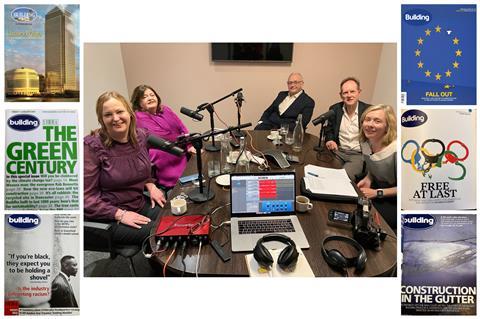
For this last edition of the magazine in the year of its 180th anniversary, I invited four previous editors to look back collectively at their work on thwe title over a period spanning four decades, from the 1980s up to very recent history. A remarkable amount has changed in that time, for construction as well as for publishing.
In a podcast episode out this month, our former Building editors – Peter Bill, Adrian Barrick, Denise Chevin and Sarah Richardson – have shared their personal memories of the biggest projects of their day, the larger-than-life characters as well as the scandals and sagas that became front-page stories for our readers.
If you listen to our conversation (available on our website and wherever you get your podcasts) you will hear the fondness with which they remember their respective times at the helm. But there are also moments of great drama and sadness – such as when Peter recalls the IRA bomb in London’s South Quay in 1996 which exploded right outside Building’s offices.
The anecdotes come thick and fast as each editor explains the context of their time in charge. The listener hears from them in chronological order to get a sense of the passage of time – but what also emerges from their lively exchange is just how much has stayed the same.
Fierce construction debates about modular buildings, skills shortages, landbanking, low margins and sustainability are nothing new, and it is fascinating to hear just how far these issues go back.
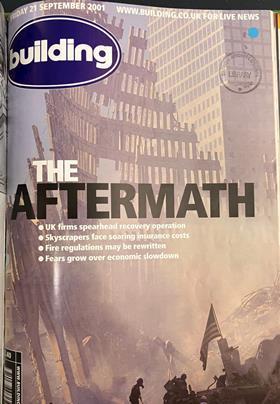
So much happened under their editorships that, before the recording, I thought it would be hard to pull out a clear narrative arc spanning the decades. But actually the journey they describe starts in place of relative economic and political stability – where the country’s success was largely driven by high investment in construction. The place we find ourselves now on that journey feels very different indeed.
Construction always has its ups and downs, being – as we are all too well aware – so dependent on economic cycles. Still, when you hear Adrian talk about his era under the Tony Blair government you realise what a high point that was for the industry.
>> Also read: Selected articles republished from our 180 year archive
His team knew that public sector spending was lavish – reflected in the fact they dubbed a Building event at the time “Blair’s Billions”. But what they did not know was that this sort of largesse was a one-off not to be repeated, and today there is no realistic prospect of it returning even if a Labour government wins next year’s election.
But this podcast was not a rose-tinted trip down memory lane. All the editors felt construction and publishing have made positive steps forward since their day. Denise was the first woman editor and recalls how at one of her project visits it was assumed she must have been the cleaner because there was an expectation that no women would be involved in construction.

Peter admitted that talk of mental health in his time was taboo – it just did not happen, and for that reason it was not covered by the magazine. And Sarah pointed to the very welcome, though much overdue focus on safety culture in the wake of the Grenfell disaster.
Advances in technology have also transformed our working lives and Adrian’s launch of Building’s first website in 1996 – plans for which he sketched out on a piece of paper – says a lot about how far we have all come.
I greatly enjoyed recording this podcast with some talented journalists who shaped Building over the years, and helped to make it what it is today. As editors – past and present – we have all felt the need to hold the industry to account while also defending its interests. We have all believed in the importance of Building being construction’s critical friend.
Below are some extracts from the recording that give a flavour of their recollections, which are at times poignant and thought-provoking, but also light-hearted and funny. I cannot think of a better way to round off Building’s 180th year:
Peter Bill (executive editor 1988-1990, editor 1990-1996)

I joined in 1985 and my impressions were that I had arrived at my natural home. After 20 years in the construction industry, and a couple of years in trade magazines, I had been working with all men. Now I was working somewhere where there were lots of women in fairly important positions. For the previous 25 years of my life, the women made the tea.
So you suddenly came into this atmosphere, where it was sort of half and a half. Admittedly most of the men were the reporters and most of the women were the sub-editors – I remember that now. However, it was wonderful to have that atmosphere, to feel you were in a much more civilised place because it was sexually balanced.
A low point, of course, was the bomb which went off just as I was going over to the pub, basically, about 6.55pm one Friday evening, 9 February 1996. We were then in Builder House, which was opposite where the bomb was parked underneath the Docklands Light Railway.
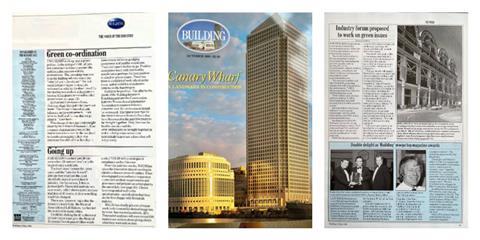
It went off like the closing of the gates of hell, frankly; it was the most enormous resonant boom. And it was so big a bomb that it caused a vacuum on the back of our offices, which blew all the windows out – or blew them in, I can’t remember which. And thank God for the safety glass because people would have been cut to pieces. It blew me across the room and frightened the life out of many people.
The upside to it was that we managed to get the magazine out that week. A third of the magazine had gone to press but the rest was still being put together. And what we did was ditch the middle third all together. We just dropped that and then did the news.
And so the magazine came out that Friday. And, when it came out, I burst into tears. It was a very emotional time.
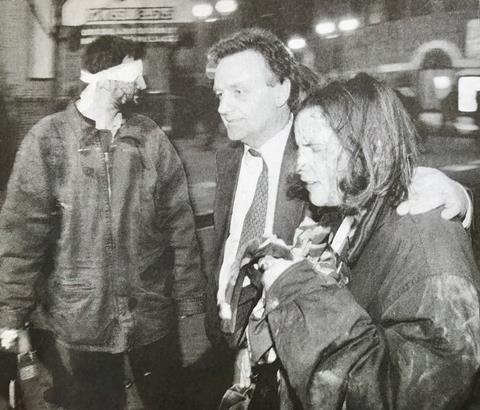
Adrian Barrick (editor 1996-2004)

I took over about six months after Peter left – and I think my era was slightly less eventful. Although it was a period of great transition actually, both from a publishing perspective but also from what was going on in the industry as well.
One of the first things that I did was to launch Building’s first website, which I designed myself. I mean, this is how sort of inept and amateurish it all was. I literally drew it out on a piece of paper, because I am a complete technophobe, and then got this agency to mock it up. And I had £1,000 from the publisher, and the reason I only got that [little] amount was that he was absolutely convinced that the internet was a passing fad.
We thought it was an important thing to do, that magazine a brand as prestigious as Building should have a website. But we had no idea what it was going to become.
We wanted to get at the heart of a lot of the challenges that the industry faced, so we campaigned for the development of the private finance initiative, because although it was a controversial policy brought in by the Blair government, it seemed to be the only chance to build schools and hospitals and transport. So we got behind that – we ran a campaign called “Untie the PFI”, which ran for six months and I think we were able to claim it had some success.
We also shone a spotlight on some of the darker corners of the industry – on some of the racism, the misogyny, and tackling skill shortages.
For our first issue of 2001, which was technically the start of the new century, the cover line was “The green century” and we did a whole special issue on that. There was a lot of scepticism about the calibre of green buildings. I think there was a feeling that the green stuff was a bit experimental. And, you know, I’m not sure that everyone quite believed that it was going to be the mainstream.
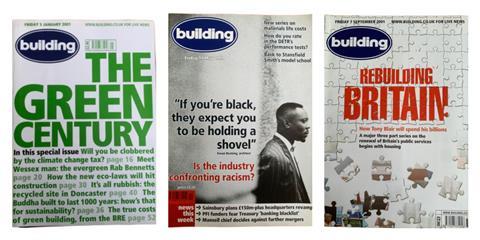
Denise Chevin (editor 2004-2010)

When I took over, it wasn’t so much thinking: “Oh, I’m the first woman.” It was more you were the guardian of something, a real icon in the sector. You really felt you wanted to strive for the highest standards.
We were trying to be quite creative and surprise people because, although it was well established, you still wanted to be fresh, you wanted slightly quirky covers.
When I took over it was very much Blair and Brown in the driving seat. You had the Building Schools for the Future initiative and you had people like Zaha Hadid designing an academy in Brixton. That’s just incredible when you look at the warehouses that are being built today that masquerade as schools.
Preparations for the Olympics were also in full swing. You had the whole Wembley stadium saga with Multiplex. And housing was actually big on the agenda. We had John Prescott and his communities plan and his £60k house, which subsequently I learnt was just a headline for the [Labour] conference – a headline that then had to be translated into policy.
Then of course you had the whole consolidation [of QS firms], those grand names like EC Harris and Davis Langdon, and it was like the ceiling was going to fall in when they got bought out.
During the 2008 crash, housebuilders were hit. I think Barratt’s shares were down at something like 30p. David Higgins, who was the chief executive of English Partnerships, had to bail out the housebuilding industry, giving a lot of upfront money where you have section 106 agreements for social housing.

Sarah Richardson (editor 2012-2017)
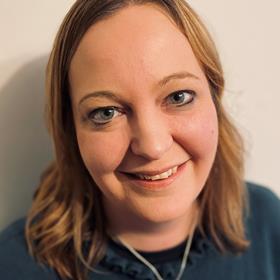
So, when I took over in 2012, I do remember a cover with a picture of the Olympic Stadium against this kind of very atmospheric sky. For that we did – what some might say was slightly cheesy, but it felt right – a “You did it!” headline.
But it really did feel like a celebration of what the industry had achieved and also the transformation of that area of east London and Stratford. I remember, right in the early days, going around the site and you were just being driven around what looked like wasteland with David Higgins. Seeing that transformation from that to when the games were staged… it was absolutely fantastic.
[Aside from the Olympics] I think people were becoming much more aware there were a lot of constraints on the industry. There was a lot more focus on maximising the efficiency of everything, including in construction.
We had the Mark Farmer Modernise or Die report. And, of course, Brexit. I think by the time I left people were obviously very concerned about the impact on the labour market in particular and materials as well.
At the end of my tenure, obviously, there was the tragedy at Grenfell, which then refocused the industry, quite rightly, on safety.
I do remember the day Grenfell happened. We started to hear what was unfolding early in the morning. We came into the office and the phone calls we were getting were from companies wanting us to know that it was nothing to do with them.
And that kind of “it’s not us” – there were obviously firms expressing condolences as well – but it did strike me that that “don’t try and point the finger at us” was the overriding kind of contact that we were getting from firms. When you look back, that was symptomatic of some of how the culture of the industry was. I hope that it is changing.
Generally, I look back on it with great fondness – for the people in the industry and the people, the journalists I worked with too.


Building Talks
You can hear this bonus episode of the podcast series by clicking on the player at the top of the story and below. And if you wish to subscribe for all the episodes in the current series, then go to one of the main podcast providers such as Spotify and Apple. Or you can find more audio on our website.
From the archives
This year marks the 180th anniversary of Building, and to celebrate we are regularly republishing an article from the archives. Building, first launched as The Builder in 1843, is one of the world’s oldest surviving trade publications.
>> Britain celebrates victory in Europe, 1945
>> The Chrysler Building and the Empire State Building, 1930





















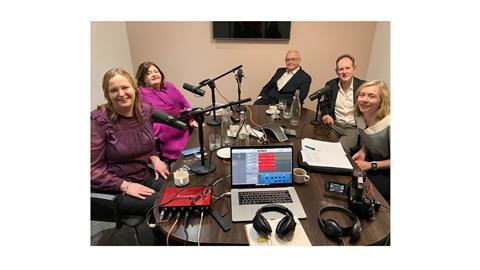




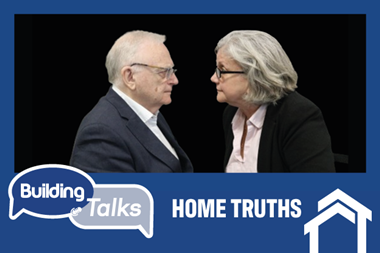
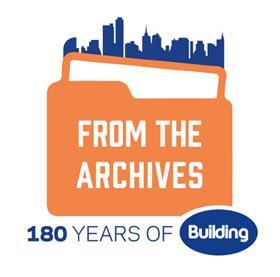

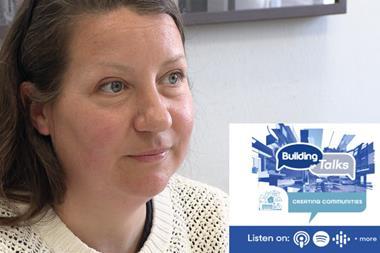






No comments yet